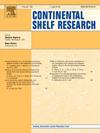关于风力驱动的欧洲陆架海平面变化及其相关的海洋环流
IF 2.2
3区 地球科学
Q2 OCEANOGRAPHY
引用次数: 0
摘要
爱尔兰、法国和英国西部的大陆架是一个洋流和海平面在一系列时间尺度上以一种显著的方式响应风活动的地区。利用测高获得的测量数据和对风的再分析,我们在目前的贡献中证明了次年海平面变化如何被理解为对风作用的响应。风通过埃克曼运输将水吹向(远离)海岸线,产生沿大陆架和横跨大陆架的连贯的海平面变化,并在海岸产生最大振幅。风与等深线的对齐决定了海平面变化的幅度。为了研究这些变化对环流变率的影响,我们收集了30多个近期环流变化的现场观测数据集。利用这些测量结果,我们发现,从戈班山口到法罗设得兰海峡的陆架边缘环流的次年变化是由埃克曼驱动的水向海岸线积聚引起的陆架海平面变化的地转调整引起的。我们的分析表明,通过这种机制产生的沿等深线流主要存在于陆架上方,仅冲击上斜坡,而不影响更深(>500 m)以上的环流。尽管如此,重要的斜坡环流,如洛卡尔斜坡流,在其滨侧受到这一简单地转调整过程的实质性影响。由于大陆架上的海平面变化在很远的距离上都是共同变化的,相关的洋流变化也有显著的沿等深线的一致性,但我们警告说,不要断定这是“欧洲斜坡流”从葡萄牙到挪威环绕欧洲斜坡的连续性的证据。本文章由计算机程序翻译,如有差异,请以英文原文为准。
On the wind-driven European shelf sea-level variability and the associated oceanic circulation
The shelf to the west of Ireland, France and the United Kingdom is a region where currents and sea level respond to the wind activity in a remarkable manner throughout a range of timescales. Using altimetry-obtained measurements and a wind reanalysis, we demonstrate in the present contribution how the sub-annual sea-level variability can be understood as a response to the wind action. The winds drive water towards (away from) the coastline through Ekman transport, yielding sea-level changes coherent along and across the shelf and with maximum amplitude at the coast. The alignment of the winds with the isobaths determines the magnitude of sea-level changes. To investigate the impacts of these changes on the circulation variability, we bring together a comprehensive dataset of 30+ in-situ observations of recent current changes. Using these measurements, we show that sub-annual changes in the shelf-edge circulation from the Goban Spur to the Faroe-Shetland Channel arise from the geostrophic adjustment to shelf sea-level variations induced by the Ekman-driven accumulation of water towards the coastline. Our analysis suggests that the along-isobath current generated through this mechanism are primarily found over the shelf, only impinge on the upper slope, and do not affect the circulation above greater depth (500 m). Nonetheless, important slope circulations such as the Rockall Slope Current are substantially influenced on their shoreward side by this simple geostrophic adjustment process. Because sea-level changes co-vary over large distances on the shelf, there also is remarkable along-isobath coherence in the associated current changes but we warn against concluding this is evidence for the continuity of an ‘European Slope Current’ circumnavigating the European slope from Portugal to Norway.
求助全文
通过发布文献求助,成功后即可免费获取论文全文。
去求助
来源期刊

Continental Shelf Research
地学-海洋学
CiteScore
4.30
自引率
4.30%
发文量
136
审稿时长
6.1 months
期刊介绍:
Continental Shelf Research publishes articles dealing with the biological, chemical, geological and physical oceanography of the shallow marine environment, from coastal and estuarine waters out to the shelf break. The continental shelf is a critical environment within the land-ocean continuum, and many processes, functions and problems in the continental shelf are driven by terrestrial inputs transported through the rivers and estuaries to the coastal and continental shelf areas. Manuscripts that deal with these topics must make a clear link to the continental shelf. Examples of research areas include:
Physical sedimentology and geomorphology
Geochemistry of the coastal ocean (inorganic and organic)
Marine environment and anthropogenic effects
Interaction of physical dynamics with natural and manmade shoreline features
Benthic, phytoplankton and zooplankton ecology
Coastal water and sediment quality, and ecosystem health
Benthic-pelagic coupling (physical and biogeochemical)
Interactions between physical dynamics (waves, currents, mixing, etc.) and biogeochemical cycles
Estuarine, coastal and shelf sea modelling and process studies.
 求助内容:
求助内容: 应助结果提醒方式:
应助结果提醒方式:


